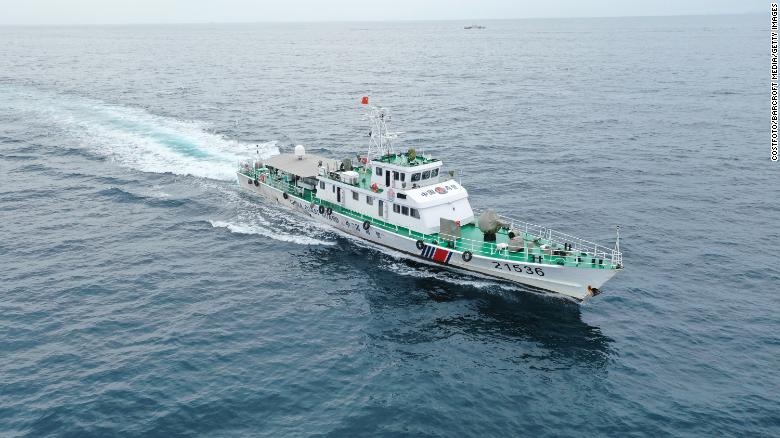The long arm of China's new maritime law
  Beijing wants foreign vessels to give notice before entering "Chinese territorial waters," providing maritime authorities with detailed information – including the ship's name, call sign, current position, next port of call and estimated time of arrival.
It may sound like a reasonable enough request, especially if the ship is carrying hazardous goods, that is until you consider what constitutes "Chinese territorial waters."
Beijing asserts sovereignty over vast swathes of the South China Sea, under its widely contested and far-reaching nine-dash line, as well as disputed islands in the East China Sea.
Begging the question, will China try to enforce the new law in disputed seas? If it does, Pacific powers like Japan and the United States almost certainly won't comply. And in such a scenario, the question quickly becomes, how will China react?
As of September 1, five types of foreign vessels – submersibles, nuclear-powered vessels, ships carrying radioactive materials, ships carrying bulk oil, chemicals, liquefied gas or other toxic substances, as well the seemingly catch-all "vessels that may endanger China's maritime traffic safety" – will be required by law to provide detailed information to state authorities on entering "Chinese territorial waters," according to a notice released by China's maritime safety authorities last Friday.
However, the regulations lack specifics and Western analysts say they skirt close to countering the United Nations Convention on the Law of the Sea, which guarantees a coastal state will not hamper the right of passage of foreign vessels if they don't threaten a nation's security.
"This looks like part of China's strategy of casting legal nets over areas that it claims ... to 'normalize' these claims," said Robert Ward, senior fellow for Japanese security studies at The International Institute for Strategic Studies in London.
"Enforcement will be difficult, but this may matter less for Beijing than the slow accumulation of what it sees as a legal underpinning for its claims."
The new regulations are the second such instance of Beijing attempting to provide a legal justification for its maritime reach this year, following a law introduced in February that allows the Chinese Coast Guard to use weapons to protect China's national sovereignty, an action previously reserved for units of the People's Liberation Army.
The main focus of both of China's new legal claims is widely considered to be the South China Sea, almost all of which Beijing claims as its sovereign territory, despite overlapping claims by the Philippines, Vietnam, Malaysia, Brunei, Indonesia and Taiwan.
The US Coast Guard's top commander in the Pacific, Vice Adm. Michael McAllister, on Friday called the new law "very concerning," telling CNN that if enforced, it "begins to build foundations for instability and potential conflicts" in the South China Sea.
The US has shown a staunch unwillingness to comply with China's demands in the region, routinely carrying out freedom of navigation operations, which challenge Beijing's claims to disputed islands. During a speech in Singapore in July, US Secretary of Defense Lloyd Austin pushed back against what he described as China's illegitimate claims to the vast resource-rich waterway.
But the more volatile area may be in the East China Sea, and the waters around the Japanese-held Senkaku Islands, claimed by China as the Diaoyus.
"Exercising coastal state rights is an important step in corroborating sovereignty through practice," said Alessio Patalano, professor of war and strategy at King's College in London. "But in spaces like the waters around the Senkaku Islands, a strict implementation of these navigational rules will inevitably lead to a clash with coast guard authorities of competing claimants like Japan."
And, looking at the numbers, the forces that could precipitate a clash have been in place almost constantly this year.
According to Japan's Coast Guard, Chinese Coast Guard vessels have been in Japan's territorial waters – within 12 nautical miles of Japanese land – 88 times this year. In the contiguous zone – waters between islands but not within 12 miles of shore – there have been 851 Chinese incursions, the Japan Coast Guard says.
But China says its coast guard vessels are only patrolling its waters around its Diaoyu islands. According to Beijing, Japanese craft are the interlopers and China would be within its rights to use force to get rid of them.
"If the vessel is military and trespassing in China's territorial waters without advance notice, it will be considered as serious provocation, and the Chinese military will take over to dispel or take even stronger measures to punish the invaders," the state-owned Global Times nationalist tabloid reported this week, quoting a Chinese military expert.
China has been ramping up legal pressure on the Senkakus since 2013, when it declared them part of an Air Defense Identification Zone (ADIZ), with requirements similar to the latest Maritime Safety Administration rules. And that ADIZ has not resulted in armed clashes.
But, as many analysts point out, combat often comes by mistake, not careful planning. A field commander eager to show his or her mettle, a mistaken order or miscommunication, a mechanical breakdown of a ship or plane – any could be a spark that ignites a conflict.
And in the current state of bellicose rhetoric between China and Japan, and its ally the United States, once shots are fired, it could be hard to back down. Brad Lendon is a senior producer for CNN International in Hong Kong. He covers military affairs in the Asia-Pacific region. Steve George is Senior Editor for CNN International in Hong Kong. He oversees coverage from across the Asia-Pacific region, with a special focus on China. Around Asia 
 A cloned cat and a nation of suitors  Ping An, a cloned cat with a flat face and fluffy tail, is China's most eligible feline.
The eight-month-old British longhair was last December at Qingdao Agricultural University, according to state-run tabloid Global Times.
Researchers collected somatic cells from the original cat, which were then cultured, frozen, and implanted into another cat's ovaries to create cloned embryos. The embryos were placed in a surrogate mother, which gave birth to Ping An, whose name means "safety."
Now, Ping An has reached maturity, and according to researchers at Qingdao Agricultural University, is ready to begin mating. The only question is: who could be a suitable mate?
It's not as simple as finding a bachelor that catches her eye – this is an opportunity for researchers to evaluate the reproductive system of a clone. That means they need to find a prime male specimen of the same species, strong and healthy without any genetic disorders.
The university put out an open call for applicants, and received a flood of interested cat owners.
"My cat Mocha looks handsome and has a nice personality," one online user said, according to the state-owned Global Times, adding that their cat had "no bad habits or chaotic social life."
Others replied to the open call by sharing photos of their cats basking in the sun, laying in bed – even "playing" the piano.
"Refuse arranged marriages, support kitty free love," another user joked on the social media platform Weibo.
Researchers have selected a potential winner that fits their requirements – but the cat will need to undergo physical exams before he's allowed to get cozy with Ping An. Jessie Yeung is a digital producer for CNN International in Hong Kong. She covers breaking news in the Asia-Pacific region.   China will set up a new stock exchange in Beijing, giving the nation's capital and political center more influence in the world of business and finance.
President Xi Jinping announced the Beijing-based exchange at an international trade fair on Thursday, saying he wanted to create a venue for "service-oriented" and "innovative" businesses. He did not announce a date for the establishment of the exchange.
China already has two stock exchanges, but they are located in Shanghai and Shenzhen, far away from Beijing. The Shanghai exchange, which was established in 1990, hosts mostly large-cap companies, including state-owned enterprises, bank and energy firms. The Shenzhen exchange includes tech companies and small and medium-sized companies.
The move comes as the Chinese government's regulatory crackdown on large private companies intensifies. Beijing has been working for nearly a year to rein in their power and influence.
It is also the second time Xi has personally announced a stock market initiative. In 2018, as the US-China trade war raged, he unveiled a tech-focused board for startups on the Shanghai Stock Exchange. The move was aimed at channeling investment into China's high-tech companies and helping the country gain an edge in its tech competition with the West. Since then, more than 300 tech firms have listed on the board, with a total market cap of more than 4.7 trillion yuan ($728 billion). Laura He is a reporter and digital producer for CNN Business. She covers news about Asian business and markets from Hong Kong. MEANWHILE IN CHINA You are receiving this newsletter because you're subscribed to Meanwhile in China.
No longer want to receive this newsletter? Unsubscribe. Interested in more? See all of our newsletters.
Create CNN Account | Listen to CNN Audio | Download the CNN App
® © 2021 Cable News Network, Inc. A WarnerMedia Company. All Rights Reserved. One CNN Center Atlanta, GA 30303
|






